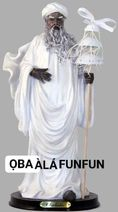Who is the real Arugbo ojo
ARÚGBÓ ỌJỌ́ !!!
WHO IS THE ANCIENT OF DAYS(ARÚGBÓ ỌJỌ́)?
Is yahweh or maybe Jesus his son really the ancient of days(arúgbó ọjọ́)?
Assuredly not! That was a pilfered epithet cum panegyric wrongfully used by Christians today to exalt their God. An eulogy that was not even meant for God, the most high but a lesser being! Albeit, we(traditionalist) wouldn't deny the Christians the usage of such epithet to eulogize their Jewish imported deity, but we seek whenceforth to inform you that we shall consider the usage as a SACRILEGE if such cognomen is used for Olódùmarè.
OBATALA is the arúgbó ojo(ancient of days), the king of kings and the lord of lords. Obàtálá got his ditto moniker from the story of his inception and the creation of human kind. It was believed that Obàtálá was the first òrìṣà and so the oldest, who led other òrìṣà to the planet earth. His continuum existence as immortal made his adherents betell him as arúgbó ọjọ́(ancient of days), olú aiye (Lord of the earth), bàbà arúgbó (old Master/father), bàbà araye(Master /father of all human beings), alabalase( he that hath divine authority), òrìṣà ńlá (the great and arch divinity).
Eepa òrìṣà
Obàtálá, Obanla o rin n'eru ojikutu s'eru.
Oba n'ile Ifon alabalase oba patapatan'ile iranje.
Arúgbó ọjọ́
O yo kelekele o ta mi l'ore.
O gba a giri l'owo osika.
O fi l'emi asoto l'owo.
Oba igbo oluwaiye re e o ke bi owu la.
O yi 'ala.
Osun l'ala o fi koko ala rumo.
Oba igbo.
Aase.
Meanwhile, "Obàtálá" his most commonly called name is derived from the words: OBA TI O NI ALA, meaning THE KING IN THE WHITE APPAREL, THE LORD OF THE WHITE CLOTH, it can also be interpreted as THE KING WITH DISTINCTIVE Boundary. He is also known as ORISAALA(Deity with distinctive boundaries) and ÒRÌSÀ ŃLÁ A, which means the great divinity, or ‘the one of most grandeur’.
OBÀTÁLÁ Known as an Ancient energy, it embodies the patience, clarity of mind and wisdom that can only be attained through thoughtfulness and careful and sober consideration. Thus, Obatala is also associated with the concept of justice. Those operating in this òrìṣà’s field are often highly intelligent and extremely thoughtful, possessing lofty yet realistic ideals. They are the observers and intellectuals among us who strive for peace, truth and clarity above all else.
Father of humanity, the right hand of Olodumare, Obatala is the supreme deity of justice, wisdom and life. Obatala’s color is white, which is often accented with other colors, namely red, coral, green or purple, according to the road. His symbols are a single, solid silver bracelet, a white horsetail switch (Irukere), a cane and a silver bell or “Agogo-Oje,” which is used when saluting him.
Obatala is the the Orisha responsible for molding the physical form of humanity before Oludumare gives us life with his divine breath. He’s always perfectly clean and expresses himself with the presence of Efun (white chalk). Liquor and red palm oil are taboo to him and his followers. Obatala is the òrìṣà of logic, thought, and clarity and as such children of Obatala are generally logical and “heady.” In fact, children of Obatala invariably require more “alone time” than most other people as their lives are often ruled by their ability to think quietly and process. Obatala is symbolized by the color white, white doves and the number 8 and ọjọ́ àìkú(Sunday) is said to be his sacred day of the week.
Obàtálá “King of the White Cloth” and he represents peace, sober decision making, creativity, purity, and divination. The social role associated with him is that of an Elder or Sage and his elements or natural stages are the mountains, clouds, and palm trees. Some of the most distinctive features of Obàtálá are the myth of creation that has been linked to him, the traditional offerings presented to him and the location of his supposed home, his “claim over individuals”, and the many associations with others Saints and deities that he has received through time.
As the Yoruba myth points out, Obatalá enjoyed drinking palm wine and continued to do so although it had previously led to his shame and humiliation. Due to his weakness for alcohol, he would even drink while carrying out his duties of molding and creating human bodies. Due to his carelessness, some of the beings he created were born with deformities and malformations so he was ordered by Olodumare to abstain from drinking while creating humans. Therefore, people born with birthmarks, albinos, the handicapped, or other children born with deformities are recognized as “Obatalá’s children”. This originates from the belief among people that “Obatalá always marks his children”.
Traditionally, offerings to “King of the White Cloth” are comprised of coconut, cotton, cocoa butter, cornstarch, and bitter kola. The home of this deity is said to be the mountains, and for this reason gifts and food are carried to these specific regions. The metal of Obatalá is silver and his color is white, hence his name which means “King of the White Cloth”. His priests and priestesses always wear only white in his honor, and the vast majority of the offerings taken to Obàtálá are white, such as white food, white clothes, white beads, and white flowers. Obatalá also tends to receive silver jewelry and coins.
Obatala is the father of all Òrìsàs and the owner of all ori. Any Òrìṣà may claim an individual, but until that individual is initiated into the priesthood of that ÒRÌSÀ , Obàtálá still owns that head. This is an important concept because it is believed that the souls of people are located in their heads. It has been claimed that Obàtálá is the oldest Òrìsà and that he is the “King of Kings”. For this reason, he is also recognized as the father of all Òrìsàs. He is known to have two wives, Yemoo, and Igbin. Obatalá is known to be patient and to possess good judgment, he is also believed to cause earthquakes when he becomes infuriated.
Obatala is the father of all children on earth, is the creator of human beings and everything that inhabits the planet. As the creator, he is the ruler of all human body parts, mainly the head, thoughts and human life, the white owner or where it participates essentially white to symbolize peace and purity. Obatala is the owner of the white metals, especially silver. Represents the creation that is not necessarily pristine, so magnanimous and above, also the pride, anger, despotism and those with defects and physical and mental difficulties.
Obatala embraces all his children with patience and love. Among its many qualities is that he brings intelligence, peace and calm to the world. He Intercede with any Òrìsà for any individual who have difficulty, because it is considered the father of mankind and owner of all heads. When we seek to Obàtálá , we looked at the top of the mountain. He’s in the snow covering the mountain peak and is seen as the wise old man(arúgbó ọjọ́) of the hills. Obatala provide justice, renewal and new beginnings. Their children, “direct” are Albinos and those born with physical and or mental. The unique function of Obatala within the realm of Mysteries of Nature is to provide the spark of light that animates consciousness. To call an Òrìsà the Chief of the White Cloth is to make a symbolic reference to that substance which makes consciousness possible.
The reference to White Cloth is not a reference to the material used to make the cloth, it is a reference to the fabric which binds the universe together. The threads of this fabric are the multi-leveled layers of consciousness which Ifa teaches exist in all things on all levels of Being. The ability of Forces of Nature to communicate with each other, and the ability of humans to communicate with Forces in Nature that gives the world a sense of spiritual unity. It is the understanding of this ability which gives substance to the Ifa concept of good character, and it is Obatala who guides us towards developing this understanding.
All Forces in Nature come into Being through the manifestation of energy patterns called Odu. Ifa has identified and labeled different Odu which can be thought of as different expressions of consciousness. But because consciousness itself is generated by Obatala, every Odu contains an element of Obatala’s spiritual power. In metaphysical terms, this means that all of Creation is linked to Obatala as the Source of Being. All forms of consciousness contain a spark of spiritual power from Obatala, and it is this spark that links everything that is, to its shared Beginning.
Du reste, there are many incarnations of the deities who had lived before and who had translated to eternity. Ogiyan in Ejigbo, Ayelala in Ekiti, Ondo and Ijebu may have been incarnations of Obatala as well as Oluorogbo in the city of Ile-Ife. This is evident in the feeding preference and dressing of the devotees of these deities. These incarnations may have been his children who migrated out of Ilé-Ifè, to resettle in these new locations. They were subsequently honored and later deified probably because of their father’s magnanimity and prowess.
The insignia of Obàtálá is ‘Opa’, the staff; and is consequently the word to which a suffix or prefix is added to make the name complete. In other places, Òrìsà is used instead of Opa to delineate Obàtálá as the king of all the Òrìsàs. It is to the same Opa that sacrifices are offered. It is taboo for it to lie by its sides.
There is a myth that speaks of a time when Heaven and Earth were side-by-side. And human beings could travel back-and-forth between Heaven-Orun and Earth-Aiye with little difficulty. But as with such things a man violated a temple regarding such travel that Obàtálá had put in place. When Obatala became aware of the situation, he became furious. He Took the Opa in hand and begin to pound furiously on the ground. He commanded that from thenceforth, human beings would no longer be able to travel into heaven. He decreed that only after death would man be able to enter the Orun. And at Obàtálá's command, the Earth and Heaven became separated.





Comments